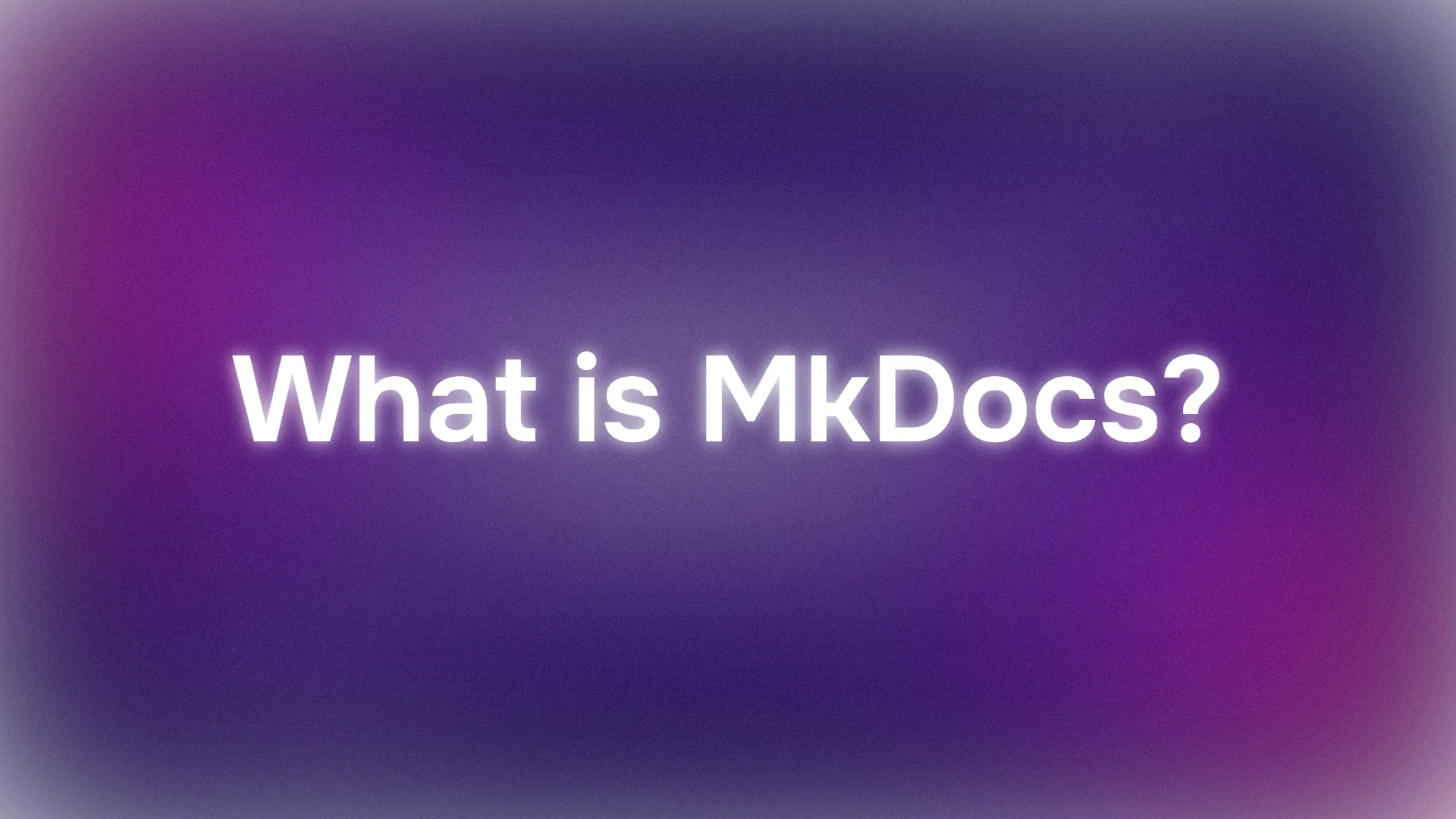Want to whip up sleek, professional API docs without wrestling complex tools? Say hello to MkDocs, a fast and simple static site generator that turns your Markdown files into gorgeous documentation sites. I’ve been playing with MkDocs to create API docs, and trust me—it’s a breeze for beginners and pros alike. In this beginner’s guide, I’ll walk you through what MkDocs is, how to install it, use it to build API documentation, and deploy it to GitHub Pages, all based on the official steps. Plus, I’ll toss in a quick nod to APIdog’s Documentation as a fancier alternative. Ready to make your API docs shine? Let’s dive in!
What is MkDocs? A Quick Intro
MkDocs is an open-source static site generator designed for creating project and API documentation. You write your content in Markdown—a lightweight, text-based format—and MkDocs transforms it into a modern, static HTML site with navigation, search, and customizable themes, no database or server-side scripting required. It’s perfect for API documentation because it’s simple, supports Markdown for easy content creation, and generates static files you can host anywhere, like GitHub Pages or Read the Docs. Developers praise its speed and ease, and the MkDocs GitHub community is buzzing with plugins and themes to jazz it up. Whether you’re documenting a REST API or a Python package, MkDocs keeps things clean and user-friendly. Let’s get it set up!
Setting Up Your Environment for MkDocs
Before we start building with MkDocs, let’s prep your system. This is super beginner-friendly, and I’ll explain each step so you’re never lost.
Check Prerequisites: You’ll need a couple of tools installed:
- Python: Version 3.7 or higher (MkDocs dropped Python 2 support). Run
python --versionin your terminal. If it’s missing or outdated, download it from python.org. On Windows, ensure Python is added to your PATH during installation—check the box in the installer. - pip: Python’s package manager, usually included with Python 3.4+. Verify with
pip --version. If it’s missing, downloadget-pip.pyfrom the web and runpython get-pip.py. - Git: Optional for deployment to GitHub Pages. Check with
git --version. Install from git-scm.com if needed.
Missing anything? Install it now to avoid hiccups.
Create a Project Folder: Let’s keep things tidy by making a dedicated folder for your MkDocs project:
mkdir mkdocs-api-docs
cd mkdocs-api-docs
This folder will hold your MkDocs files, and cd moves you into it, ready for action.
Set Up a Virtual Environment: To avoid package conflicts, create a Python virtual environment:
python -m venv venv
Activate it:
- Mac/Linux:
source venv/bin/activate - Windows:
venv\Scripts\activate
You’ll see (venv) in your terminal, meaning you’re in a clean Python environment. This isolates MkDocs’s dependencies, keeping your system neat.

Installing MkDocs
Now, let’s install MkDocs and get it ready to build your API documentation. This is quick and straightforward.
Install MkDocs: With your virtual environment active, run:
pip install mkdocs
This grabs MkDocs from PyPI and installs it. It might take a moment to download dependencies like Markdown and Pygments.
Verify Installation: Check that MkDocs is installed correctly:
mkdocs --version
You should see something like mkdocs, version 1.6.1 (or newer). If it fails, ensure pip is updated (pip install --upgrade pip) or that Python is in your PATH.
Install a Theme (Optional): MkDocs comes with basic themes (readthedocs & mkdocs), but the Material for MkDocs theme is a fan favorite for its modern look. Install it:
pip install mkdocs-material
This adds a polished, customizable theme perfect for API docs. We’ll use it later to make your site pop.

Creating and Using Your MkDocs Project
Time to create your MkDocs project and build some API documentation! We’ll set up a simple site to document a fictional REST API, with a homepage and an endpoints page.
Initialize a New Project: In your mkdocs-api-docs folder (with the virtual environment active), create a new MkDocs project:
mkdocs new .
This creates:
mkdocs.yml: The configuration file for your site.docs/: A folder with anindex.mdfile, the default homepage.
The docs/ folder is where your Markdown files go, and index.md is your site’s entry point.
Edit the Configuration File: Open mkdocs.yml in a text editor (e.g., VS Code with code .). Update it to set the site name, theme, and navigation for your API docs:
site_name: My API Documentation
theme:
name: material
nav:
- Home: index.md
- Endpoints: endpoints.md
This sets the site name, applies the Material theme (if installed), and defines a navigation menu with two pages: “Home” (index.md) and “Endpoints” (endpoints.md). Save the file.
Write Your API Documentation: Let’s create content for your API docs:
Edit docs/index.md: Replace its contents with:
# Welcome to My API Documentation
This is the documentation for our awesome REST API. Use the navigation to explore endpoints and get started!
Create docs/endpoints.md: Add a new file in the docs/ folder named endpoints.md with:
# API Endpoints
## GET /users
Retrieves a list of users.
**Example Request**:
```bash
curl -X GET https://api.example.com/users
Response:
[
{"id": 1, "name": "Alice"},
{"id": 2, "name": "Bob"}
]
These Markdown files define your API’s homepage and a sample endpoint, using code blocks for clarity. Feel free to add more endpoints or details!
Preview Your Site: Start the MkDocs development server to see your docs live:
mkdocs serve
This builds your site and hosts it at http://127.0.0.1:8000/. Open that URL in your browser, and you’ll see your API docs with a navigation bar, search, and the Material theme’s sleek design (if installed). The server auto-reloads when you edit mkdocs.yml or Markdown files, so tweak away and watch changes live!

I tested this setup, and my API docs looked professional in under 10 minutes—navigation worked, and the search found my endpoint details instantly. If the server doesn’t start, check that port 8000. is free or that mkdocs is installed correctly.

Deploying Your MkDocs Site
Your API docs are looking sharp locally—now let’s share them with the world by deploying to GitHub Pages, a free hosting option.
Create a Git Repository: Initialize a Git repository in your mkdocs-api-docs folder:
git init
git add .
git commit -m "Initial MkDocs project"
This sets up version control. Add site/ and venv/ to a .gitignore file to exclude build artifacts and the virtual environment:
site/
venv/
Push to GitHub: Create a new repository on GitHub (e.g., my-api-docs) and push your project:
git remote add origin https://github.com/yourusername/my-api-docs.git
git branch -M main
git push -u origin main
Replace yourusername with your GitHub username. This uploads your MkDocs project to GitHub.
Deploy to GitHub Pages: Build and deploy your site:
mkdocs gh-deploy
This command builds your site, commits the static files to a gh-pages branch, and pushes it to GitHub. MkDocs uses the ghp-import tool behind the scenes to handle this. Your site will be live at https://yourusername.github.io/my-api-docs/ (give it a few minutes to propagate).
I ran this for my test site, and it was up on GitHub Pages in under a minute, accessible to anyone with the link. If it doesn’t work, ensure your GitHub repository is public and check mkdocs gh-deploy --help for options.
Exploring MkDocs Alternatives: APIdog’s Documentation
While MkDocs is fantastic for lightweight API documentation, you might want a tool with more bells and whistles. Enter APIdog’s Documentation, a powerful alternative that’s nicer-looking, feature-rich, and supports self-hosting. APIdog integrates API design, testing, and documentation in one platform, offering interactive API playgrounds, automated testing, and collaborative features—perfect for teams needing more than static docs. It’s a bit more complex than MkDocs, but if you want a polished, all-in-one solution, give APIdog a spin!

If you're just getting started with writing documentation or looking to elevate your documentation skills—especially when working in teams or handling complex projects—I strongly recommend you trying out Apidog. It offers a plethora of features that simplify managing documentation for complex or collaborative projects. And the best part is, you can get started for free!
Tips for MkDocs Success
- Customize Your Theme: Tweak the Material theme in
mkdocs.ymlwith options likepalette: { scheme: slate }for a dark mode vibe. - Add Plugins: Install plugins like
mkdocs-mkdocstringsfor Python docstring integration ormkdocs-pdf-export-pluginfor PDF exports. - Use Markdown Extensions: Enable extensions in
mkdocs.yml(e.g.,markdown_extensions: - toc: permalink: true) for tables of contents or admonitions. - Check Logs: If
mkdocs serveorgh-deployfails, check terminal output ormkdocs --helpfor clues. - Explore the Community: Join the MkDocs GitHub Discussions or Gitter chat for tips and plugin ideas.
Wrapping Up: Your MkDocs Adventure Begins
Congrats—you’ve installed, used, and deployed MkDocs to create slick API documentation! From setting up a project to deploying on GitHub Pages, you’ve built a professional site that’s easy to maintain and share. Try adding more endpoints, experimenting with plugins, or tweaking the theme to make it your own. If you want a feature-packed alternative, check out APIdog’s Documentation for a next-level experience! Happy documenting!



